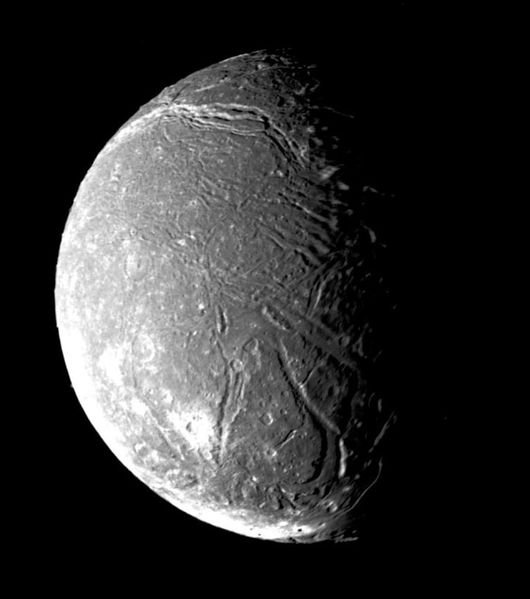From Wikipedia, the free encyclopedia
 Size of this preview: 530 × 599 pixel
Size of this preview: 530 × 599 pixel
Image in higher resolution (767 × 867 pixel, file size: 47 KB, MIME type: image/jpeg)
 |
This is a file from the Wikimedia Commons. The description on its description page there is shown below. |
|
|
Commons is attempting to create a freely licensed media file repository. You can help.
|
| Description |
English: Original Caption Released with Image: This mosaic of the four highest-resolution images of Ariel represents the most detailed Voyager 2 picture of this satellite of Uranus. The images were taken through the clear filter of Voyager's narrow-angle camera on Jan. 24, 1986, at a distance of about 130,000 kilometers (80,000 miles). Ariel is about 1,200 km (750 mi) in diameter; the resolution here is 2.4 km (1.5 mi). Much of Ariel's surface is densely pitted with craters 5 to 10 km (3 to 6 mi) across. These craters are close to the threshold of detection in this picture. Numerous valleys and fault scarps crisscross the highly pitted terrain. Voyager scientists believe the valleys have formed over down-dropped fault blocks (graben); apparently, extensive faulting has occurred as a result of expansion and stretching of Ariel's crust. The largest fault valleys, near the terminator at right, as well as a smooth region near the centre of this image, have been partly filled with deposits that are younger and less heavily cratered than the pitted terrain. Narrow, somewhat sinuous scarps and valleys have been formed, in turn, in these young deposits. It is not yet clear whether these sinuous features have been formed by faulting or by the flow of fluids. JPL manages the Voyager project for NASA's Office of Space Science.
Deutsch: Voyager 2-Aufnahme von Ariel
|
| Source |
http://photojournal.jpl.nasa.gov/catalog/PIA01534 |
| Date |
|
| Author |
|
| Permission |
 |
This file is in the public domain because it was created by NASA. NASA copyright policy states that "NASA material is not protected by copyright unless noted". ( NASA copyright policy page or JPL Image Use Policy). Warnings:
- Use of NASA logos (which include the current "meatball" logo, the old "worm" logo, and the seal) is restricted.
- The NASA website hosts a large number of images from the Soviet/ Russian space agency, and other non-American space agencies. These are not in the public domain.
- Materials from the Hubble Space Telescope may be copyrighted if they do not explicitly come from the STScI.
- All materials created by the SOHO probe are copyrighted and require permission for commercial non-educational use.
- Images featured on the Astronomy Picture of the Day (APOD) web site may be copyrighted.
|
|
|
File links
The following pages on the English Wikipedia link to this file (pages on other projects are not listed):

